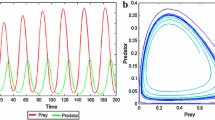Summary
A mathematical model of the functional response to prey density involving the hunger effect was constructed in this paper. In that model, the amount of prey captured by predators, y, is assumed to be proportional to the product of the prey density, x, and the degree of hunger. The range of prey density is divided into the following three areas along the x-axis, according to the maximum rate of ingestion and the maximum rate of capture: (i) the area in which the value of y increases convexly with increasing x, (ii) the area in which the value of y increases proportionally to x and (iii) the area in which y reaches the maximum.
It is shown that these equations are a generalization of Ivlev's equation, and Holling's disc epuation, that is, both equations hold in special cases in only the first area of x.
These equations were applied to several experimental results obtained by using two kinds of wolf spiders and some values of parameters were estimated.
Similar content being viewed by others
References
Calhoun, J. B.: Social welfare as a variable in population dynamics. Cold Spr. Harb. Symp. quant. Biol. 22, 339–356 (1957)
Haynes, D. L., Sisojević, P.: Predatory behavior of Philodromus rufus Walekenaer (Araneae: Thomisidae). Canad. Ent. 98, 113–133 (1966)
Holling, C. S.: Some characteristics of simple types of predation and parasitism. Canad. Ent. 91, 384–398 (1959)
Holling, C. S.: Principles of insect predation. Ann. Rev. Ent. 6, 163–182 (1961)
Holling, C. S.: The functional response of invertebrate predators to prey density. Mem. ent. Soc. Canada No. 48, 1–86 (1966)
Ivlev, V. S.: Experimental ecology of the feeding of fishes (English translation by D. Scott). New Haven: Yale University Press 1955
Miyashita, K.: Quantitative feeding biology of Lycosa T-insignita Boes. et Str. (Araneae: Lycosidae). Bull. nat. Inst. Agr. Sci., C No. 22, 329–344 (1968)
Nakamura, K.: The ingestion in wolf spiders. II. The expression of degree of hunger and amount of ingestion in realation to spider's hunger. Res. Popul. Ecol. 14, 82–96 (1972)
Rashevsky, N.: Some remarks on the mathematical theory of nutrition of fishes. Bull. Math. Biophys. 21, 161–183 (1959)
Rogers, D.: Random search and insect population models. J. anim. Ecol. 41, 369–383 (1972)
Royama, T.: A comparative study of models for predation and parasitism. Res. Popul. Ecol. Suppl. No. 1, 1–91 (1971)
Watt, K. E. F.: A mathematical model for the effect of densities of attacked and attacking species on the number attacked. Canad. Ent. 91, 129–144 (1959)
Author information
Authors and Affiliations
Rights and permissions
About this article
Cite this article
Nakamura, K. A model of the functional response of a predator to prey density involving the hunger effect. Oecologia 16, 265–278 (1974). https://doi.org/10.1007/BF00344737
Received:
Issue Date:
DOI: https://doi.org/10.1007/BF00344737




